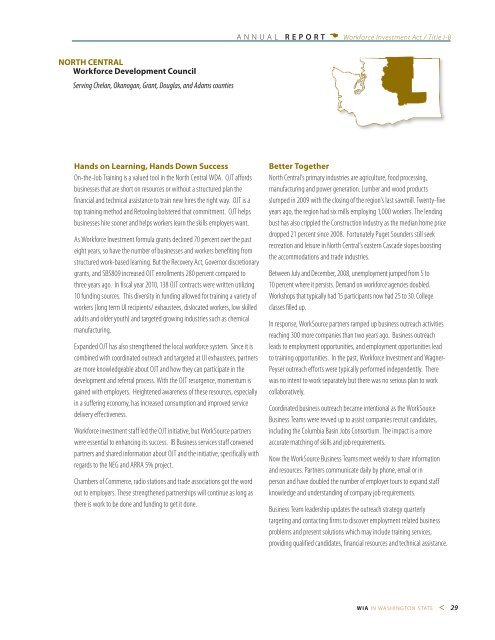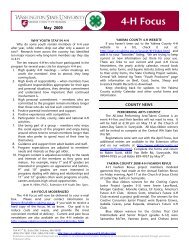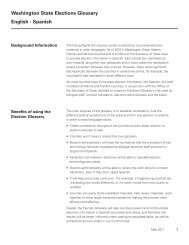washington state - Workforce Training and Education Coordinating ...
washington state - Workforce Training and Education Coordinating ...
washington state - Workforce Training and Education Coordinating ...
Create successful ePaper yourself
Turn your PDF publications into a flip-book with our unique Google optimized e-Paper software.
A N N U A L R E P O R T D <strong>Workforce</strong> Investment Act / Title I-BNORTH CENTRAL<strong>Workforce</strong> Development CouncilServing Chelan, Okanogan, Grant, Douglas, <strong>and</strong> Adams countiesH<strong>and</strong>s on Learning, H<strong>and</strong>s Down SuccessOn-the-Job <strong>Training</strong> is a valued tool in the North Central WDA. OJT affordsbusinesses that are short on resources or without a structured plan thefinancial <strong>and</strong> technical assistance to train new hires the right way. OJT is atop training method <strong>and</strong> Retooling bolstered that commitment. OJT helpsbusinesses hire sooner <strong>and</strong> helps workers learn the skills employers want.As <strong>Workforce</strong> Investment formula grants declined 70 percent over the pasteight years, so have the number of businesses <strong>and</strong> workers benefiting fromstructured work-based learning. But the Recovery Act, Governor discretionarygrants, <strong>and</strong> SB5809 increased OJT enrollments 280 percent compared tothree years ago. In fiscal year 2010, 138 OJT contracts were written utilizing10 funding sources. This diversity in funding allowed for training a variety ofworkers (long term UI recipients/ exhaustees, dislocated workers, low skilledadults <strong>and</strong> older youth) <strong>and</strong> targeted growing industries such as chemicalmanufacturing.Exp<strong>and</strong>ed OJT has also strengthened the local workforce system. Since it iscombined with coordinated outreach <strong>and</strong> targeted at UI exhaustees, partnersare more knowledgeable about OJT <strong>and</strong> how they can participate in thedevelopment <strong>and</strong> referral process. With the OJT resurgence, momentum isgained with employers. Heightened awareness of these resources, especiallyin a suffering economy, has increased consumption <strong>and</strong> improved servicedelivery effectiveness.<strong>Workforce</strong> investment staff led the OJT initiative, but WorkSource partnerswere essential to enhancing its success. IB Business services staff convenedpartners <strong>and</strong> shared information about OJT <strong>and</strong> the initiative, specifically withregards to the NEG <strong>and</strong> ARRA 5% project.Chambers of Commerce, radio stations <strong>and</strong> trade associations got the wordout to employers. These strengthened partnerships will continue as long asthere is work to be done <strong>and</strong> funding to get it done.Better TogetherNorth Central’s primary industries are agriculture, food processing,manufacturing <strong>and</strong> power generation. Lumber <strong>and</strong> wood productsslumped in 2009 with the closing of the region's last sawmill. Twenty-fiveyears ago, the region had six mills employing 1,000 workers. The lendingbust has also crippled the Construction industry as the median home pricedropped 21 percent since 2008. Fortunately Puget Sounders still seekrecreation <strong>and</strong> leisure in North Central’s eastern Cascade slopes boostingthe accommodations <strong>and</strong> trade industries.Between July <strong>and</strong> December, 2008, unemployment jumped from 5 to10 percent where it persists. Dem<strong>and</strong> on workforce agencies doubled.Workshops that typically had 15 participants now had 25 to 30. Collegeclasses filled up.In response, WorkSource partners ramped up business outreach activitiesreaching 300 more companies than two years ago. Business outreachleads to employment opportunities, <strong>and</strong> employment opportunities leadto training opportunities. In the past, <strong>Workforce</strong> Investment <strong>and</strong> Wagner-Peyser outreach efforts were typically performed independently. Therewas no intent to work separately but there was no serious plan to workcollaboratively.Coordinated business outreach became intentional as the WorkSourceBusiness Teams were revved up to assist companies recruit c<strong>and</strong>idates,including the Columbia Basin Jobs Consortium. The impact is a moreaccurate matching of skills <strong>and</strong> job requirements.Now the WorkSource Business Teams meet weekly to share information<strong>and</strong> resources. Partners communicate daily by phone, email or inperson <strong>and</strong> have doubled the number of employer tours to exp<strong>and</strong> staffknowledge <strong>and</strong> underst<strong>and</strong>ing of company job requirements.Business Team leadership updates the outreach strategy quarterlytargeting <strong>and</strong> contacting firms to discover employment related businessproblems <strong>and</strong> present solutions which may include training services,providing qualified c<strong>and</strong>idates, financial resources <strong>and</strong> technical assistance.WIA IN WASHINGTON STATE < 29
















